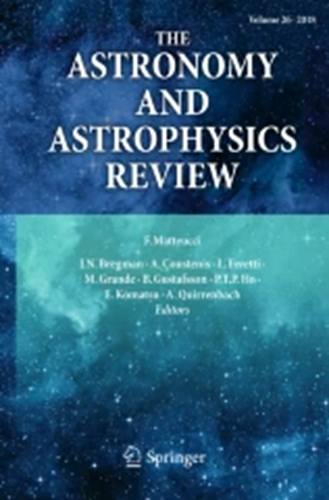神秘的、多变的、极热的:白矮星显示出超高的激发线
IF 26.5
1区 物理与天体物理
Q1 ASTRONOMY & ASTROPHYSICS
引用次数: 5
摘要
大约10%的恒星在进入白矮星冷却序列时,在其光谱中表现出超高激发(UHE)金属(例如OVIII)的吸收线。最近发现的一颗光谱和光度都可变的UHE白矮星导致人们猜测,UHE谱线可能是在激波加热的星周磁层中产生的。我们对所有16颗目前已知的UHE白矮星(包括一颗新发现的)和8颗只显示HeII线问题的白矮星进行了几次地面和太空调查,研究了(多波段)光曲线,因为这两种现象被认为是相互关联的。我们发现75美元^{+ 8}_{-13}$ %特别恶劣的白矮星,75 ^ {+ 9}_ {-19}$ % HeII线问题的白矮星明显光测量的变量,时间从0.22到2.93 d和振幅从几个十几个一百杂志。高变异率是与此形成鲜明对比的是,变异率在正常热白矮星(我们发现9美元^{+ 4}_{2}$ %),标记过程和HeII线问题白矮星变星的一个新类。如果我们假设样本中的物体会因进一步收缩而自旋上升,那么我们样本的周期分布与后共包络双星的轨道周期分布和磁性白矮星的旋转周期分布都是一致的。由于没有向长波方向增加的光度振幅,以及在我们恒星的光谱中没有检测到从假设的次级星的高度辐照面产生的光学发射线,因此似乎不太可能是受辐照的晚型伴星是光度变化的起源。相反,我们认为这些恒星表面的斑点和/或星周物质的几何效应可能是原因。(简略)本文章由计算机程序翻译,如有差异,请以英文原文为准。
Mysterious, variable, and extremely hot: White dwarfs showing ultra-high excitation lines
About 10% of all stars exhibit absorption lines of ultra-high excited (UHE) metals (e.g. OVIII) in their optical spectra when entering the white dwarf cooling sequence. The recent discovery of a both spectroscopic and photometric variable UHE white dwarf led to the speculation that the UHE lines might be created in a shock-heated circumstellar magnetosphere. We investigate (multi-band) light curves from several ground- and space-based surveys of all 16 currently known UHE white dwarfs (including one newly discovered) and eight white dwarfs that show only the HeII line problem, as both phenomena are believed to be connected. We find that $75^{+8}_{-13}$% of the UHE white dwarfs, and $75^{+9}_{-19}$% of the HeII line problem white dwarfs are significantly photometrically variable, with periods ranging from 0.22d to 2.93d and amplitudes from a few tenth to a few hundredth mag. The high variability rate is in stark contrast to the variability rate amongst normal hot white dwarfs (we find $9^{+4}_{-2}$%), marking UHE and HeII line problem white dwarfs as a new class of variable stars. The period distribution of our sample agrees with both the orbital period distribution of post-common envelope binaries and the rotational period distribution of magnetic white dwarfs if we assume that the objects in our sample will spin-up as a consequence of further contraction. The lack of increasing photometric amplitudes towards longer wavelengths, as well as the non-detection of optical emission lines arising from the highly irradiated face of a hypothetical secondary in the optical spectra of our stars, makes it seem unlikely that an irradiated late type companion is the origin of the photometric variability. Instead, we believe that spots on the surfaces of these stars and/or geometrical effects of circumstellar material might be responsible. (abridged)
求助全文
通过发布文献求助,成功后即可免费获取论文全文。
去求助
来源期刊

The Astronomy and Astrophysics Review
地学天文-天文与天体物理
CiteScore
45.00
自引率
0.80%
发文量
7
期刊介绍:
The Astronomy and Astrophysics Review is a journal that covers all areas of astronomy and astrophysics. It includes subjects related to other fields such as laboratory or particle physics, cosmic ray physics, studies in the solar system, astrobiology, instrumentation, and computational and statistical methods with specific astronomical applications. The frequency of review articles depends on the level of activity in different areas. The journal focuses on publishing review articles that are scientifically rigorous and easily comprehensible. These articles serve as a valuable resource for scientists, students, researchers, and lecturers who want to explore new or unfamiliar fields. The journal is abstracted and indexed in various databases including the Astrophysics Data System (ADS), BFI List, CNKI, CNPIEC, Current Contents/Physical, Chemical and Earth Sciences, Dimensions, EBSCO Academic Search, EI Compendex, Japanese Science and Technology, and more.
 求助内容:
求助内容: 应助结果提醒方式:
应助结果提醒方式:


